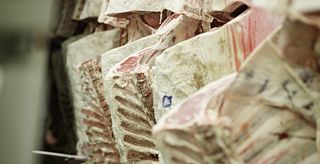Beef Production
The journey of raising beef is among the most complex of any food. Due in part to their changing nutritional needs throughout their lifetime, beef cattle often times will change hands and ownership up to three or four times, over the course of one and a half to three years, as they move through their various life stages.
Across this process, however, one important thing remains constant – and that’s the beef community’s shared commitment to raising cattle in a safe, humane and environmentally sustainable way. Working together, each segment of the beef lifecycle aims to make the best use of vital natural resources like land, water and energy - not just for today, but also for the future. The result is a delicious and nutritious food you can feel confident serving your family and friends.
THe Beef Lifecycle: From pasture to Plate
Cow-Calf Farm and Weaning
Raising beef begins with ranchers who maintain a herd of cows that give birth to calves, typically weighs 60 to 100 pounds, once a year. Calves are weaned from their mother’s milk at 6 to 10 months of age weighing between 450 and 700 pounds. These calves continue to graze on grass pastures and may begin receiving a small amount of supplemental plant based feed for extra energy and protein to help them grow and thrive.
Stocker and Backgrounding
After weaning, cattle continue to grow and thrive by grazing on grass and pastures with farmers providing supplemental feed including vitamins and minerals to meet all of their nutritional needs.
Livestock Market
After weaning and/or during the stocker and backgrounder phase, cattle may be sold at livestock auction markets.
Feedyard
Mature cattle are often moved to feedyards. Here cattle typically spend 4 to 6 months. They are free to graze at feed bunks containing a carefully balanced diet made up of roughage (such as hay and grass), grain (such as corn, wheat and soybean meal) and local renewable feed sources (more about that in the next section). Veterinarians, nutritionists and pen riders work together to provide individual care for each animal.

Processing Facility
Once cattle reach market weight (typically 1,200 to 1,400 pounds at 18 to 22 months of age), they are sent to a processing facility (also called a packing plant). United States Department of Agriculture (USDA) inspectors oversee the implementation of safety, animal welfare and quality standards from the time animals enter the plant until the final beef products are shipped to grocery stores and restaurants.


Share This Page